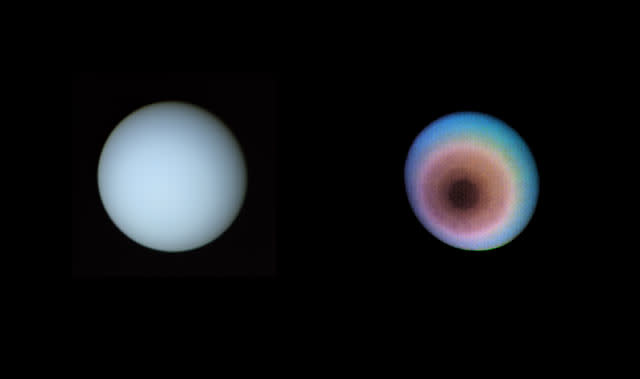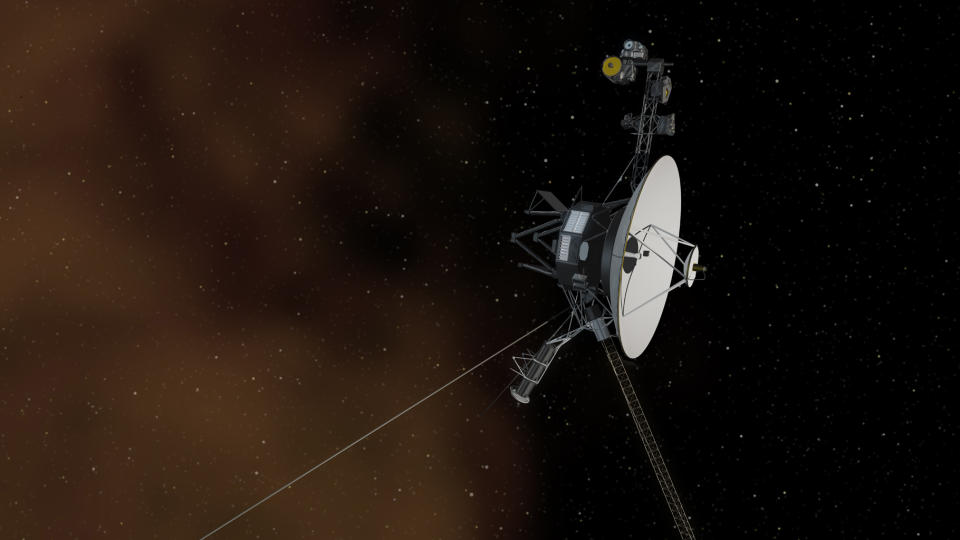Scientists may have solved a long-standing mystery surrounding the ice giant Uranus and its faint radiation belts. The belts’ weakness may be linked to the planet’s peculiarly tilted and unstable magnetic field, which could be causing a “traffic jam” for particles orbiting Earth.
The mystery dates back to Voyager 2’s visit to Uranus in January 1986, long before the probe left the solar system in 2018. The spacecraft found that Uranus’ magnetic field was asymmetrical and tilted about 60° from its spin axis. Voyager 2 also found that Uranus’ radiation belts, made up of particles trapped by that magnetic field, were about 100 times weaker than previously thought.
New research based on simulations using Voyager 2 data suggests that these two strange aspects of the ice giant are related.
“It has a magnetic field unlike anything else in the solar system. Most planets have strong internal magnetic fields, like Earth, Jupiter, and Saturn. They have a very ‘traditional’ magnetic field shape known as a dipole,” lead author Matthew Acevski told Space.com. “It’s the same magnetic field shape you’d expect from your everyday bar magnet. That’s not the case with Uranus; its field is very asymmetrical, and it gets progressively more asymmetrical as you get closer to the planets’ surface.”
Relating to: ‘True’ colour images reveal Uranus and Neptune are actually similar blues
Acevski explained that this research reveals how Uranus’ magnetic asymmetry distorts the structure of the planet’s proton radiation belts, especially near the region where Voyager 2 passed.
“My hypothesis was that magnetic asymmetry bends the proton radiation belts, creating regions around the planet where the radiation belts are more compressed,” Acevski said, “and therefore more dense; and other regions where they are more spread out have weaker density.
“If Voyager 2 passed through a region where the radiation belts are more spread out, this could explain the observations of weaker-than-expected proton radiation belts.”
An anomaly in the solar system
The coldest planet in the solar system and the seventh from the sun, Uranus is an oddity among the other worlds in our planetary system. The ice giant spins like a cosmic ball, tilted 97 degrees to one side from the plane of its orbit. That is, when it spins, it does so “sideways,” as it were. It is the only solar system planet to do so.
The tilt, believed to be the result of a collision with an Earth-sized object in the distant past, causes Uranus to have the most extreme seasons in the solar system, with a winter lasting 21 years. Uranus, which completes an orbit every 84 Earth years, is also one of only two planets in the solar system that orbits the sun in the opposite direction to all the other planets (the other being Venus).
About four times larger than Earth and about 19 times farther away than our planet, Uranus is surrounded by 13 faint rings and at least 28 moons. Uranus also has auroras similar to Earth’s northern and southern lights, but due to the planet’s tilted magnetic field these are not visible at its poles as they are on our planets Jupiter or even Saturn.
Like all planets with magnetic fields, Uranus is surrounded by charged particles that form radiation belts, but why these radiation belts appear so weak has remained a puzzle for fifty years.

The team’s simulation abandoned the idea that Uranus’ magnetic field behaved like a dipole and instead used a more complex quadrupole magnetic field to mimic its one-sided structure.
This revealed that particles speed up and slow down as they pass through regions of different field strengths. The changes in the particles’ speeds cause them to clump together in some regions and become more dispersed in others. This effect only occurs when a single, complex quadrupole magnetic field is included in the simulation, so it has never been seen before.
“We found that Uranus’ magnetic asymmetry can result in regions around the planet where protons drift more slowly and are more compressed, and other regions where they drift faster and are more spread out,” Acevski said. “This is similar to how traffic jams form on a ring road. When cars travel slower, it results in denser traffic; when cars travel faster, the traffic is more spread out.”
Acevski and his colleagues suggest that when Voyager 2 visited Uranus, it passed through a weak region of the ice giant’s radiation belt.
“We projected Voyager 2’s orbit onto this profile and found that the spacecraft actually passed through the ‘fast drift’ region, meaning it should have observed lower proton radiation belt density than normal,” Acevski said. “It is important to note that our particle simulations explain this result at a maximum variation of about 20% in the proton density around the planet.”
This means the team’s model cannot fully explain the 100-fold lower density observed by Voyager 2.
“It’s possible that the primary effect that caused these much weaker proton radiation belts was exacerbated by this effect that we found,” Acevski continued. “We were very surprised by the results. It’s surprising how much of an impact magnetic asymmetry can have on the radiation belt structure. This was something that was not known before.”


Acevski noted that the results he and his team obtained could inform future spacecraft missions to Uranus. So far, Voyager 2 is the only spacecraft to have visited the ice giant, meaning direct data about the world is extremely limited.
Plans are underway at NASA to launch a mission to Uranus as early as 2030. Such a mission could help experimentally confirm the outcome of this simulation.
“What we need to validate these simulations is a flagship spacecraft mission to Uranus to obtain new, in situ measurements of the planet over several years, rather than just a few hours as Voyager 2 did,” Acevski said. “A new mission could also reveal new physics that we couldn’t even predict with the simulations.
“Because this is a planet with a magnetic field that we’ve never seen before, it’s entirely possible that completely new events will be found that will expand our understanding of planetary science.”
Related Stories:
— In quest to find alien life, scientists are looking for extrasolar Earth-Jupiter binaries
— Infrared aurora on Uranus confirmed for first time
— James Webb Space Telescope finds jet stream on Jupiter stronger than a category 5 hurricane
Acevski is certainly not done with this strange solar system world yet. The ice giant is a particular source of fascination for the researcher.
“Uranus presents a unique challenge for science, and I really enjoy tackling it. It’s really fascinating how much you can uncover with so little data, and we’re literally just scratching the surface,” Acevski concluded. “As of today, there aren’t many people studying the icy giant planets Uranus and Neptune, even though they exhibit such strange properties, especially in their magnetic fields, and so it’s a very exciting prospect for me to point out the strange things that might be happening there.”
The team’s research was published in June in the journal Geophysical Research Letters.